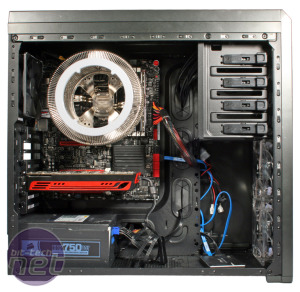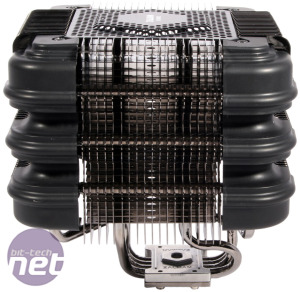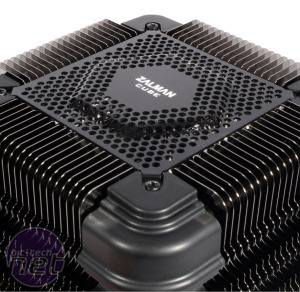
Performance Analysis
The first and most obvious thing to note is that neither Zalman's nor NoFan's passive coolers are any match for traditional fan bearing (and noise producing) coolers. Even at stock speeds, the passive coolers are at least 6°C warmer than the worst cooler we have on record for our overclocked settings.At stock speeds, the difference between the two fanless coolers is an insignificant 1°C, with the Zalman and NoFan achieving delta T results of 58°C or 59°C respectively. While these temperatures are high, they're not dangerously so, and both coolers are clearly capable of noiseless cooling. Although our test system runs with three fans, the fans themselves are fairly low airflow, so including some faster fans would probably improve the situation too.
We were also curious to see if the coolers could cope with the overclocked settings with which we stress test other coolers, and it's here that Zalman's cooler has a distinct upper hand. Within five minutes of Prime95 being loaded, our overclocked CPU with the NoFan cooler hit its thermal limit and downclocked itself, failing the test. However, although temperatures steadily climbed with the Zalman cooler, it was able to stabilise our CPU at a delta T of 69°C. This is undoubtedly a very high delta T value, but it's a victory nonetheless. It's also worth noting that once we removed the load from the CPU, temperatures fell rather quickly, so cyclic loading over time also shouldn't be an issue.
Our concerns about poor thermal transfer between the soldered heat pipes didn't seem to materialise, as every part of the FX100 Cube was very hot to the touch after testing. Finally, while the CR-95C is easier to install, it gives you less RAM clearance than the FX100 and even forced us to move our graphics card to a lower PCI-E slot, which gives the Zalman cooler a further advantage.


Click to enlarge - The big FX100 (left) and bigger CR-95C (right) mounted to our LGA1155 test system
Conclusion
When compared to traditional air coolers, there's no question that Zalman's FX100 is poor value for money. Noctua's monstrous NH-D14, for example, costs £15 less but knocks 24°C off the FX100's delta T value for our LGA1155 overclocked rig, even with its fans running at their ultra quiet low speed. For just a few extra quid than the cost of Zalman's cooler, you could also net yourself Corsair's H80i, which is a cinch to install and produces excellent temperatures, even with its fans running quietly too.Quiet isn't silent though, and that's naturally where the FX100 stands out, and the fact that it's able to (just) cope with our overclocked CPU is impressive. Naturally, we'd still recommend an air or liquid cooler if you're overclocking, particularly if you're running a hotter Ivy Bridge LGA1155 CPU. At the end of the day, it does what it says it can, as the FX100 can cool a high end CPU with no moving parts and no noise (and less dust accumulation as a result). It serves a tiny market, but it's able to outperform costlier competition from NoFan and has less clearance issues too, so if silence is your highest priority, it's certainly worth a look. We'd still prefer an ultra quiet cooler like the NH-D14, however, as its temperatures are far healthier.
-
Value20 / 30
-
Design28 / 30
-
Cooling22 / 40


MSI MPG Velox 100R Chassis Review
October 14 2021 | 15:04










Want to comment? Please log in.